Presenting my Hand-painted Homes of San Francisco
San Francisco, the City of Love, has a brand of unique and romantic architecture that sets it apart from any other city across the USA.
Its architectural history is as diverse and dynamic as its landscape, marked by a series of booms and transformations that have shaped its unique skyline and streetscapes. The city’s architectural uniqueness can be attributed to a variety of factors, including its geographical location, historical events, and cultural influences such as the Gold Rush, the Victorian Era, and the Beaux Arts Movement. This has resulted in unique home styles throughout the city that are characteristic of its charm.
Over the years I have worked on my San Francisco collection and for the first time I am presenting it here in this blog. I have reduced the number of paintings slightly so make it more “consumable” but a more comprehensive view of these paintings can be found in video form on YouTube.
I have broken my portraits into the main architectural style categories which can be found in the interesting and often hilly streets of this great city and am proud to present Hand-painted Homes of San Francisco!
Victorian Style
The Victorian architectural style in San Francisco is renowned for its unique and iconic presence. This style emerged during the reign of Queen Victoria (1837-1901), hence the name “Victorian.” The Victorian era coincides with a significant period in San Francisco’s history, including the Gold Rush and the city’s subsequent rapid growth. Many of these homes were built during the late 19th century. These homes are known for their intricate designs and ornate details. Key features often include brightly colored exteriors, decorative gables, bay windows, turrets, and elaborate woodwork. The use of vibrant colors and detailed ornamentation became particularly popular in San Francisco, leading to what is commonly known as “Painted Ladies.” These are Victorian and Edwardian houses painted in three or more colors to enhance their architectural details.




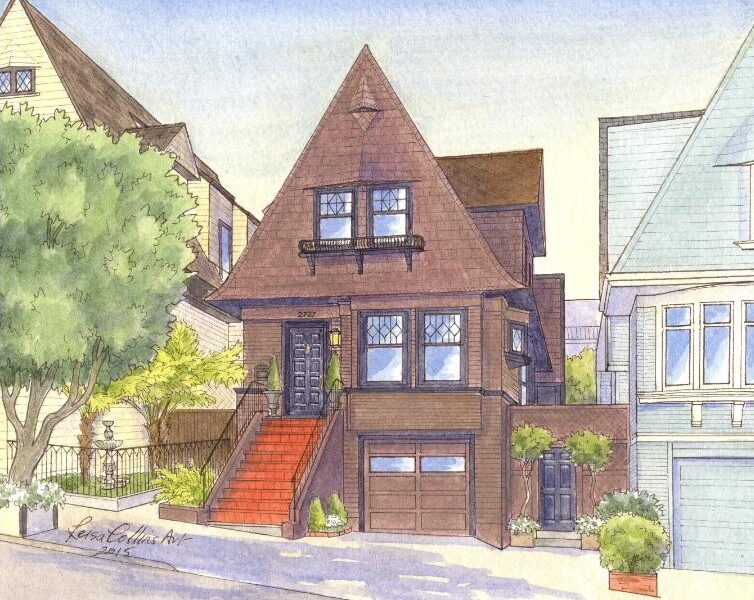
Victorian Cottage
The Victorian cottage style home in San Francisco refers to a particular architectural style that emerged during the Victorian era during Queen Victoria’s reign in Britain. This style made its way to San Francisco, particularly during the city’s rapid development in the late 19th century. These cottages are typically smaller than the more ornate Victorian mansions. They often have a more compact layout, usually one or two stories, and are designed to fit narrower city lots. Victorian cottages feature decorative details, though generally less elaborate than larger Victorian homes. This can include gingerbread trim, decorative brackets, and spindlework. Many Victorian cottages have steeply pitched gable roofs, which are sometimes adorned with finials or cresting. Like their counterpart, these homes also are adorned in elaborate color schemes and can feature bay windows.






Italiante Style
The Italianate architectural style, particularly in San Francisco, is a distinctive and historically significant aspect of the city’s urban landscape. This style, which was most popular from the late 1840s to the 1880s, reflects the influence of classical Italian Renaissance architecture, adapted to the needs and tastes of the burgeoning American cities of the time. One of the hallmarks of the Italianate style is its decorative details. These include elaborate window and door surrounds, often with arched or curved shapes, and intricate cornices with brackets and other ornamental features. Italianate homes are typically two or three stories tall, with a balanced, symmetrical façade. They often have a flat or low-pitched roof. Despite the devastation of the 1906 earthquake and fire, many Italianate homes in San Francisco survived or were rebuilt. There has been a significant movement to preserve and restore these historic homes, which are seen as an integral part of the city’s architectural heritage. Like Victorian homes, Italiante homes are often restored with vibrant color palettes.
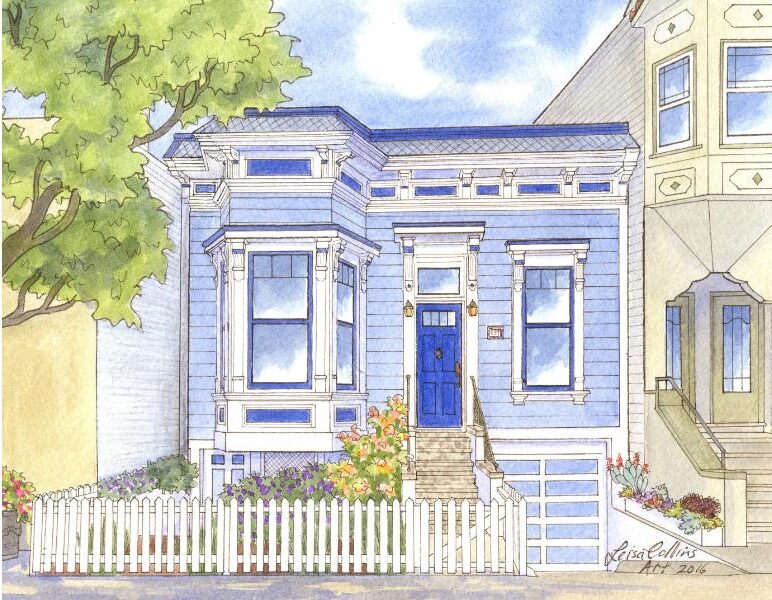

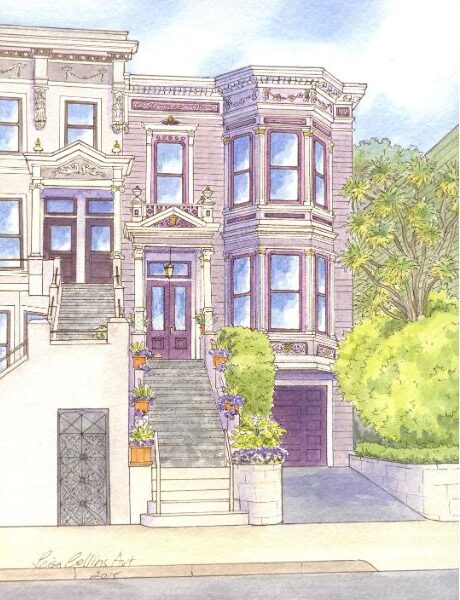


Mission Revival Style
The Mission Revival architectural style, which emerged in the late 19th and early 20th centuries, draws inspiration from the Spanish missions established in California during the colonial period. This style became particularly popular in California and other southwestern states, including San Francisco. Specifically, this style is heavily influenced by the architecture of the Spanish missions built in the 18th and 19th centuries by Spanish Franciscan missionaries. These missions had a distinct aesthetic that combined Spanish colonial and Moorish architectural elements. The most distinctive feature of this home style is the red tile roofing, often with a low pitch. Arched corridors and windows are common, reflecting the Spanish colonial heritage. Walls are typically made of stucco and there is limited ornamentation. Many homes in this style feature interior courtyards, which are a traditional element in Spanish architecture.
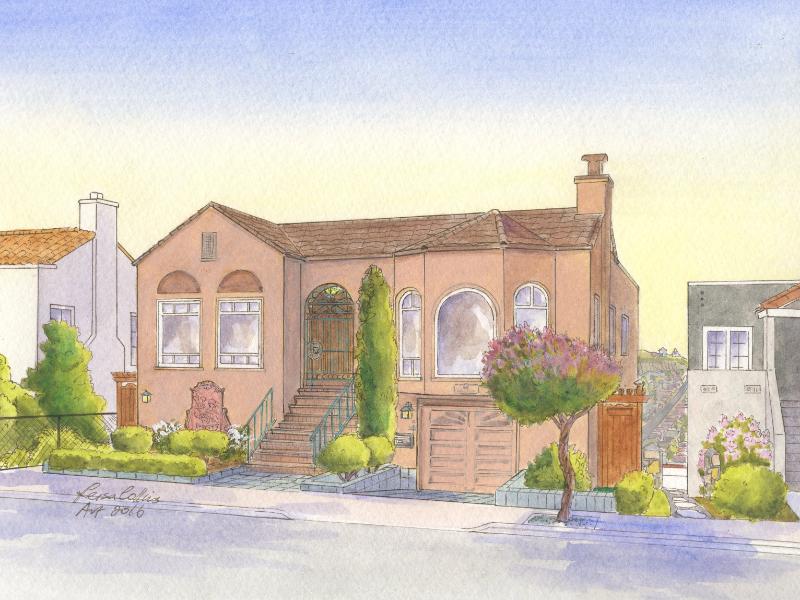



Tudor Style
Tudor style homes are a distinctive and charming architectural style that can be found in various parts of San Francisco. This style, which originated in England, gained popularity in the United States during the late 19th and early 20th centuries, becoming a common choice for residential buildings in many American cities, including San Francisco. Decorative half-timbering is a hallmark of the Tudor style, where the structural timber framing is exposed on the exterior of the building, creating a distinctive pattern. The spaces between the timber are usually filled with stucco or brick. Another hallmark are the steeply pitched gable roofs. Tudor homes often feature tall, narrow windows, typically with multiple panes. These windows are often arranged in groups and have a vertical emphasis. Tudor homes often have decorative chimney pots and elaborate designs on the chimneys themselves, adding to the distinctive look of the style. In addition to timber and stucco, Tudor style homes often incorporate brick and stone in their construction, adding to the sense of solidity and permanence.


Queen Anne
The Queen Anne style of architecture, which gained popularity in the United States during the late 19th century, is a distinctive and ornate style that is particularly well-represented in San Francisco’s historic homes. This style is a part of the broader Victorian era of architecture, which includes a range of styles popular during the reign of Britain’s Queen Victoria (1837-1901). Unlike the more symmetrical earlier Victorian styles, Queen Anne homes often feature an asymmetrical facade with bay windows, towers, or turrets. These homes are known for their elaborate and often whimsical details, including spindlework, gingerbread trim, and decorative gables. Queen Anne homes frequently use different materials and textures on their exteriors, such as patterned shingles, half-timbering, and decorative panels. Many of the surviving Queen Anne homes in San Francisco are painted in bright, multi-color schemes, enhancing their intricate details. These homes are included in reference to the “Painted Ladies,” especially in reference to the famous row of Queen Anne homes at Alamo Square. Many Queen Anne homes feature one or more spacious porches, often with ornate woodwork.


Beaux-Arts Style
Beaux-Arts architecture, a style that originated in France in the late 19th century, made a significant impact on the architectural landscape of San Francisco, particularly during its period of rapid growth and rebuilding following the 1906 earthquake and fire. This style, characterized by its grandeur, symmetry, and ornate detailing, was often employed in public buildings and wealthy residential areas. The style heavily borrows from classical Greek and Roman architecture. This is evident in the use of columns, pilasters, pediments, and classical proportions. Beaux-Arts buildings typically have a symmetrical façade with a grand, imposing presence. This is often achieved through balanced window placements, uniform sections, and a central entrance. Ornate detailing is a hallmark of the Beaux-Arts style. This includes elaborate moldings, sculptural decorations, and intricate stonework. San Francisco’s Beaux-Arts homes often feature lavish interiors with high ceilings, grand staircases, and detailed plasterwork.


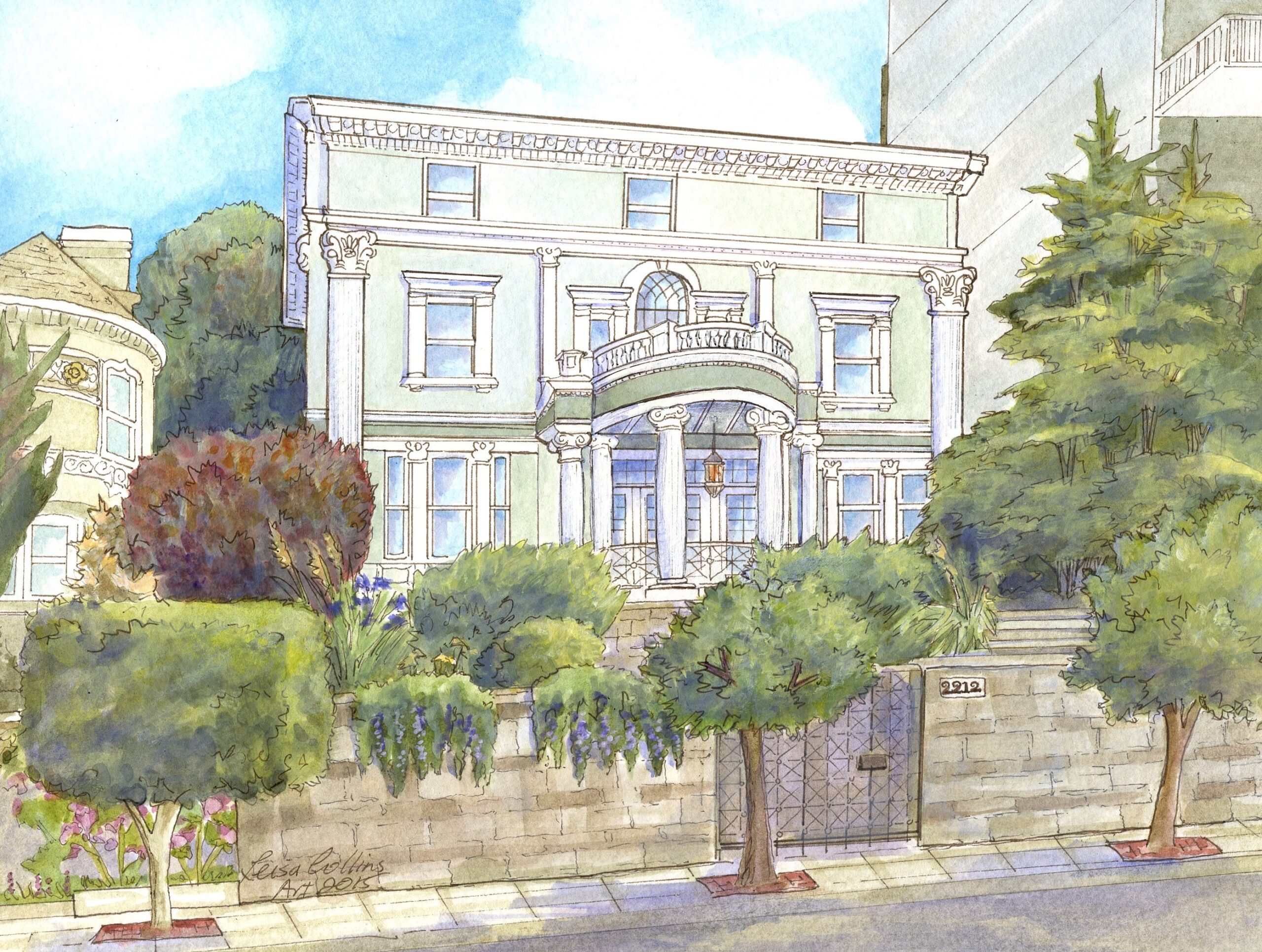
Art Deco Style
Art Deco, a popular design style of the 1920s and 1930s, is known for its bold geometric shapes, rich colors, and lavish ornamentation. This style emerged as a response to the austerity imposed by World War I and represented luxury, glamour, and technological progress. It influenced various domains, including architecture, interior design, fashion, and art. In San Francisco, Art Deco left a significant mark on the city’s architectural landscape. SanFrancisco’s iteration of Art Deco often blended with elements of Moderne, creating a unique hybrid that reflected the city’s creative and innovative spirit. Art Deco buildings in San Francisco often feature stepped forms, rounded corners, and stylized geometric details. Facades are typically adorned with motifs such as zigzags, chevrons, and sunburst patterns. These buildings often utilized new materials like chrome, stainless steel, and aluminum, alongside traditional ones like stone, stucco, and brick. The color palettes range from bold and vivid to more subdued and elegant tones. Some notable examples of Art Deco architecture in San Francisco include the Pacific Telephone Building (now known as 140 New Montgomery), theParamount Theater, and the Golden Gate Bridge, which is often associated with the ArtDeco movement because of its streamlined design and striking presence.



Rosseau “Storybrook” Style
The Rousseau “Storybook” home style in San Francisco is a distinct architectural style that emerged in the Sunset District during the 1930s. These homes were designed by brothers Arthur and Oliver Rousseau, who were part of a family of architects. The Storybook style homes they created are known for their whimsical, fairy tale-like appearance, often incorporating elements from Tudor Revival, French Revival, Mediterranean Revival, Spanish Colonial Revival, and related subtypes such as Churrigueresque and Monterey Revival styles. The Rousseau brothers’ designs stood out from the more common, simpler homes prevalent in the Sunset District at the time, offering a unique charm and a sense of optimism. These homes often featured unique floor plans, including interior patios and garages. These Storybook homes are particularly concentrated in what’s now called the”Rousseaus’ Boulevard Tract,” located between 33rd to 36th Avenues, from Kirkham to Lawton streets. This area represents the largest development of Rousseau homes in the Sunset. The enduring appeal of the Rousseau Storybook homes in San Francisco lies in their unique architectural style that evokes a sense of whimsy and nostalgia, standing as a testament to the creative vision of the Rousseau brothers.
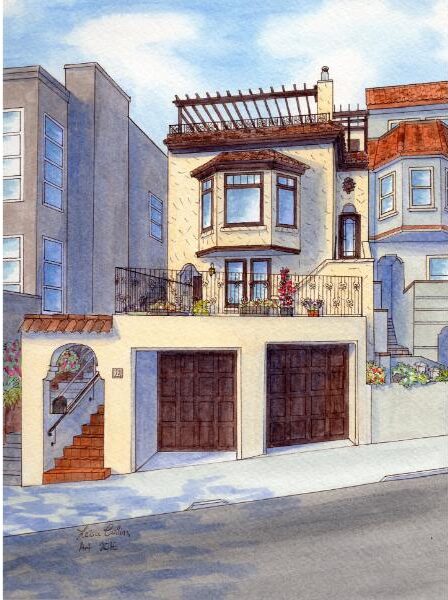




Mid-Century Modern Style
Mid-Century Modern is an architectural, interior, and product design style that emerged in the middle of the 20th century, roughly from the mid-1940s to the late 1960s. This style is characterized by a number of distinctive features, and San Francisco, with its rich architectural history, has a notable collection of Mid-Century Modern homes. Some key characteristics of Mid-Century Modern homes as they appear in San Francisco include emphasis on clean lines, simplicity, and functionality. Homes in this style often have a minimalist aesthetic with an open floor plan. Much of the architecture features geometric shapes and asymmetrical forms. Mid-Century Modern architects in San Francisco and elsewhere frequently used new materials and building techniques that were developed during and after World War II. This includes the use of steel, plywood, and concrete in innovative ways. A viewing of this style in San Francisco might see flat planes and roofs, along with this mix of different materials like wood, glass, and steel.

Contemporary Style
Contemporary home style in San Francisco, like in many urban areas, is often characterized by a blend of modern design elements and historical influences. This style is known for its emphasis on clean lines, open spaces, and a connection between indoor and outdoor living. Contemporary homes in San Francisco often feature geometric shapes and asymmetrical designs. They tend to have flat or low-pitched roofs and are frequently designed with a mix of materials such as wood, steel, glass, and concrete. These homes usually have open, airy floor plans that create a sense of spaciousness. The layout often emphasizes a flow between living, dining, and kitchen areas, with minimal obstructions like walls or partitions.Large windows, often floor-to-ceiling, are a staple in contemporary homes in San Francisco along with a minimalist aesthetic. Many contemporary homes incorporate sustainable design elements, such as energy-efficient appliances, solar panels, and environmentally friendly materials. Given San Francisco’s scenic beauty and temperate weather, contemporary homes often feature outdoor living spaces like balconies, decks, or patios, sometimes with views of the city, bay, or surrounding natural landscapes. In San Francisco, contemporary homes often exist alongside Victorian, Edwardian, and other historic styles. New constructions or renovations in contemporary style sometimes incorporate elements from these traditional styles, respecting the city’s architectural heritage.

I hope you have enjoyed my tour of some of the beautiful homes in San Francisco, in the architectural styles that this great city is known for.
This San Francisco collection has been a labor of love and as mentioned above, I am presenting it here on my blog for the first time. I have reduced the number of paintings slightly so make it more “consumable” but a more comprehensive view of these paintings can be found in video form on YouTube.
Cheers, Leisa

